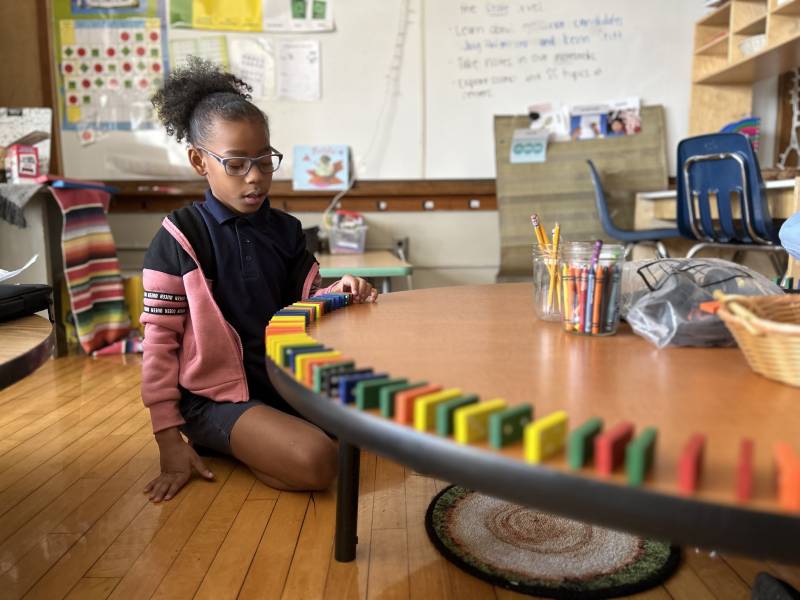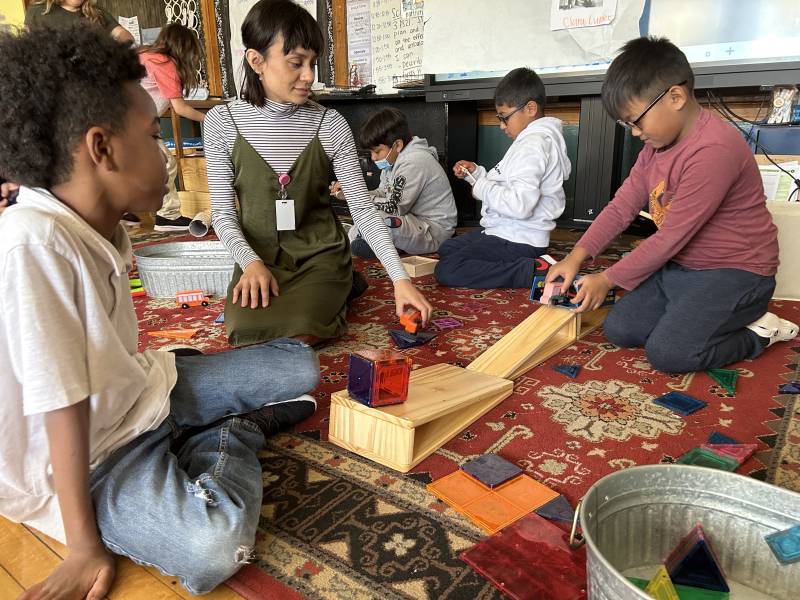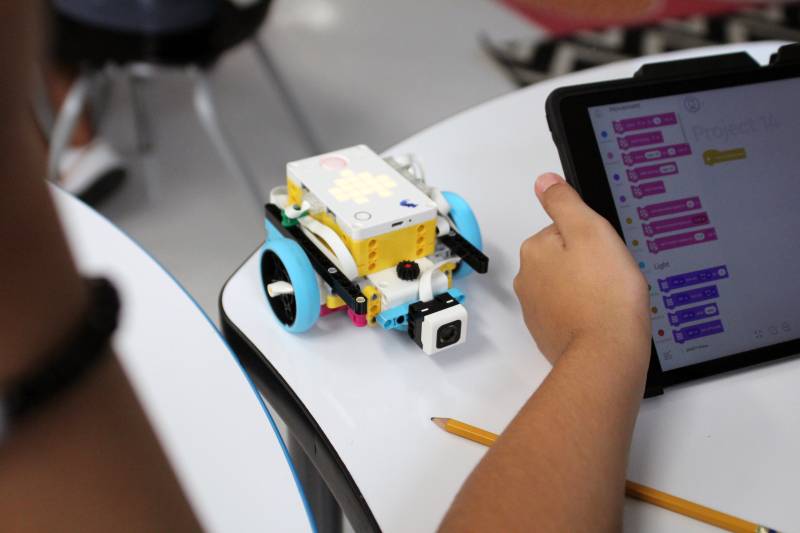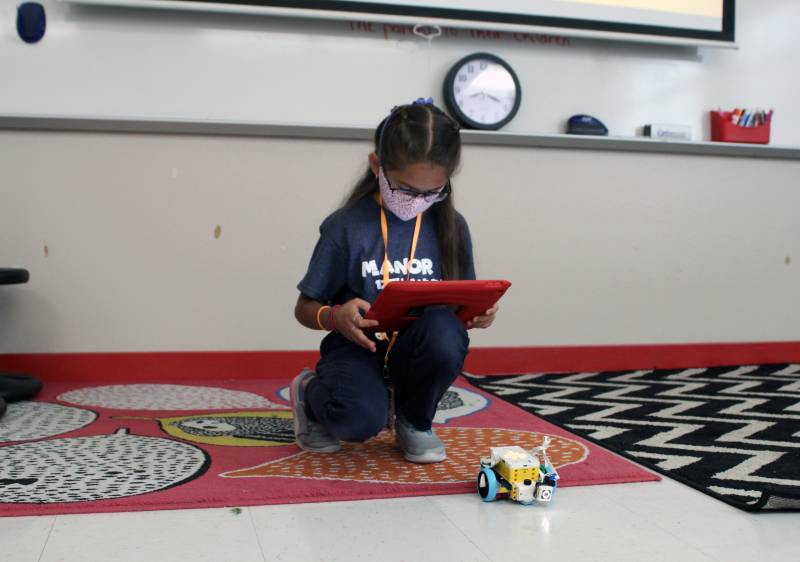While play-based learning remains relatively rare in elementary classrooms, Oklahoma City is among a small number of school districts across the country experimenting with increased play time for children as old as 8 or 9. In Watertown, New York, for example, educators have been teaching through play in pre-K and kindergarten for years, said former Superintendent Patti LaBarr, but the district recently shifted to encouraging play for older elementary students, too. And in Austin, Texas, one school official has started training elementary teachers to use Lego robotic toys as a play-based learning tool during class time.

The growing focus on play in older grades is not always easy, as teachers contend with pressure to meet standardized testing mandates and a lack of support from some administrators. But educators who have turned to play-based learning say the approach is particularly helpful now, as pandemic disruptions have left students with social, emotional and behavioral gaps.
It can be difficult to explain what play-based learning looks like, said Mara Krechevsky, senior researcher at Project Zero, an education research group in Harvard’s Graduate School of Education. Over the past seven years, Krechevsky and her research team have been working on a project called the Pedagogy of Play, studying play-based learning at schools in Boston, Denmark, South Africa and Colombia.
Through their research, Krechevsky’s group came up with three basic tenets for playful learning: students should be able to help lead their own learning, explore the unknown, and find joy. Under this framework, play time doesn’t have to be the reward for completing work and learning. Play can actually be the work, Krechevsky said.
Much of the impetus for the shift in Oklahoma City comes from Stephanie Hinton, who started overseeing pre-K through second grade at Oklahoma City Public Schools a few years ago. She knew she wanted to encourage hands-on, playful learning as much as possible. The approach worked for her as a teacher, and it’s backed up by research.
At Shidler Elementary, most students qualify for free and reduced lunch and test scores have historically been low. It’s the kind of school where, typically, it’s difficult to get everyone on board with play-based learning, Hinton said. Despite those challenges, play has begun to catch on in its classrooms.
“There is this push for skill and drill in schools and communities where we’re not passing the test,” Hinton said. It can be easy to think the solution is assigning more schoolwork and sending home more worksheets, Hinton added. That’s because worksheets are black and white — either the student knows the answer to the questions on the assignment or they don’t. But Hinton said regurgitating answers on a piece of paper isn’t a sign of understanding.
“It’s not authentic, it’s not true learning,” she said. “And we know from research that when it comes down to it, it hasn’t engaged enough of the brain to make it permanent learning.”

But letting kids learn through play is hard to grasp for educators who have been trained to follow the rules and structure of a traditional school setting, said Peg Drappo, who runs the pre-K program in Watertown City School District in New York. Watertown began to increase its focus on playful learning in 2015, when the district received a federal grant that helped expand play in its pre-K program. In the seven years since, Drappo and the district’s superintendent have been helping teachers of the older grades who approached them about adding play to their own classrooms.
But when she was an elementary school principal several years ago, Drappo didn’t understand what playful learning was supposed to look like. Now, when she speaks at conferences on play-based learning, she tells a story about visiting a kindergarten classroom when she was a principal.
“The kids were all over the place, all over the floor doing things — just like a kindergarten classroom should be. But I did not know this world of pre-K and play, so I said to [the teacher], ‘I’ll come back to your classroom when you’re teaching,’” Drappo said. “Now when I walk into a classroom and it’s loud and a teacher apologizes, I say, ‘Stop apologizing. This is how it’s supposed to sound.’”

In Oklahoma, playful learning has support from lawmakers as well.
Before becoming a teacher, Oklahoma state Rep. Jacob Rosecrants, a Democrat, thought all students were taught lessons through play.
“I became a teacher back in 2012 and I realized it’s [play] not even accepted anymore as a way to learn, even in the younger grades,” Rosecrants said. “Some schools do it great, but I’m talking about the way that I learned — going outside, playing, discovering — that type of thing was not something that was focused on in any of the public schools I went to [as a teacher].” (Rosecrants left teaching in 2017 when he was elected to represent Norman, Oklahoma in the state house.)
As a middle school teacher, Rosecrants said, he rebelled against the idea that students should learn via memorization, drills, and worksheets. In 2021, the Oklahoma legislature passed a law that encourages the use of play in pre-K through third grade classrooms. The law, which was written by Rosecrants with bi-partisan assistance, also forbids administrators from prohibiting educators’ use of a play-based approach to teaching.
“I’ve had a lot of teachers who asked me to print it out so they can post it in their classroom, because administrators will come in and be like, ‘Hey, we gotta hit this standard, what are you doing?’ And they’re like, ‘Well, we’re hitting this standard, but we’re [doing it] with blocks,’” Rosecrants said. “I want to add a piece to [the law] probably this year … to require training for play-based learning for all administrators in pre-K through third grade.”

Some schools are trying to increase play by turning to STEM-focused activities, like building robots with Legos. Manor Independent School District, a district of about 9,000 students just east of Austin, Texas, launched a robotics program around a decade ago, in an attempt to bring more playful learning to students in the early years of elementary school. For several years, robotics was mostly confined to an after-school program using Lego’s educational products.
Jacob Luevano, the innovative teaching strategist at Manor ISD, said he has been working to train teachers to integrate robotics into their classrooms. “I think now more than ever, we need [playful learning] in the classrooms,” Luevano said.
So far, Luevano has had more success in getting robotics activities introduced to classrooms in kindergarten through second grade than in upper elementary, which he attributes, in part, to the pressure of standardized testing that starts in third grade.

As children recover from the isolation of the Covid-19 pandemic, active, playful learning is more important than ever because it strengthens social and emotional skills, said Hinton in Oklahoma City.
“This isn’t just about play. This is about building relationships, and social-emotional learning,” Hinton said. “Sometimes when an adult is losing their mind about something, I think: I wonder what your play behaviors were like as a child?” It helps, she clarifies, if children have already experienced losing in a cooperative setting — whether at Monopoly, Hi Ho! Cherry-O or another game. “How you handle that, it says a lot about where you are in your social emotional development,” she said.
In O’Brien’s classroom in Oklahoma City, there are no desks. Instead, students sit at round tables or on a rug in front of the whiteboard, depending on the activity.
Recently, the class learned about static electricity. O’Brien set up stations with different items — balloons, tissue, paper — to show the kids how static electricity works.
“I asked them to figure out how they could make these different materials move without directly touching them,” O’Brien said. After that, she led a discussion on what the students discovered and presented them with some technical, scientific terms.
This year is O’Brien’s first back at Shidler Elementary. She left the district in 2021 to get a master’s degree in early childhood education and work at a private preschool in Colorado that uses the Reggio Emilia approach to teaching, an approach born in Italy that encompasses significant play.
Like other play-based programs, Reggio Emilia is most often seen in private and affluent preschool classrooms. When O’Brien made the decision to return to Shidler Elementary, she was partly on a mission to bring play-based learning to a public setting.
“It’s not something that should just be for the elite, and I think all children can benefit from learning this way,” O’Brien said.
This story about play-based learning was produced by The Hechinger Report, a nonprofit, independent news organization focused on inequality and innovation in education. Sign up for Hechinger Reporter newsletters.




